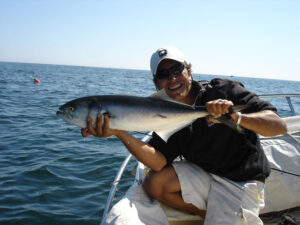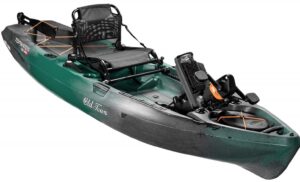Introduction
Fishing is not just a hobby; it’s a way of life! And when it comes to river fishing, the thrill and excitement reach a whole new level. The flowing waters, abundant fish species, and serene surroundings make river fishing an unforgettable experience. However, to make the most of your angling adventure, it’s crucial to have the right gear in your arsenal. In this comprehensive guide, we will explore the essential river fishing gear that will help you hook the catch of a lifetime.
1. Fishing Rods
A sturdy and reliable fishing rod is the backbone of any angler’s gear. When it comes to river fishing, you need a rod that can handle the strong currents and the fight of aggressive fish. Opt for a medium to heavy-action spinning rod or a baitcasting rod, depending on your preference and experience level. Look for a rod made of durable materials like graphite or fiberglass, as they offer excellent strength and sensitivity.
2. Fishing Reels
Choosing the right fishing reel is essential for smooth and efficient line retrieval. For river fishing, a spinning reel is often the best option. It provides versatility and ease of use, allowing you to cast with precision and handle various fishing techniques. Look for a reel with a high gear ratio for quick line retrieval and a smooth drag system to handle the powerful runs of river-dwelling fish.
3. Fishing Line
The fishing line is the lifeline that connects you to the fish. When it comes to river fishing, you need a strong and durable line that can withstand the abrasion caused by rocks, submerged logs, and other underwater obstacles. Monofilament and fluorocarbon lines are popular choices for river fishing due to their excellent strength and low visibility. Consider the fishing conditions and the target species to determine the appropriate line weight.
4. Hooks and Terminal Tackle
Having a well-stocked tackle box with an assortment of hooks and terminal tackle is essential for river fishing success. Choose hooks of various sizes and styles to accommodate different bait presentations and fish species. Additionally, include a selection of sinkers, swivels, bobbers, and leaders to customize your rig and adapt to the river’s ever-changing conditions.
5. Bait and Lures
Using the right bait or lure is crucial to enticing fish to bite. For river fishing, live bait options like worms, minnows, and crayfish are highly effective. These natural baits mimic the river’s native food sources, attracting a wide range of fish species. Additionally, artificial lures like spinners, crankbaits, and soft plastics can be used to mimic injured or fleeing baitfish, triggering predatory instincts in fish.
6. Waders and Boots
River fishing often requires getting into the water, especially when targeting fish in deeper pools or navigating rocky riverbeds. Investing in a good pair of waders and boots is essential to keep yourself dry, comfortable, and protected. Choose waders made of waterproof and breathable materials like neoprene or Gore-Tex. Pair them with sturdy boots that provide excellent traction on slippery surfaces.
7. Fishing Vest or Tackle Bag
Keeping your fishing gear organized and easily accessible is vital for a successful river fishing expedition. A fishing vest or tackle bag with multiple pockets and compartments can be your best friend on the riverbank. It allows you to carry all your essentials like tackle boxes, extra lines, tools, and even snacks without weighing you down. Look for a vest or bag with adjustable straps for a comfortable fit.
8. Fishing Accessories
There are a few additional accessories that can enhance your river fishing experience. Consider investing in a quality fishing hat or cap to protect yourself from the sun’s harmful rays. Polarized sunglasses are also a must-have to reduce glare and improve visibility in the water. Other useful accessories include a fishing net, pliers or forceps for hook removal, a fish gripper for safe handling, and a waterproof phone case to capture your memorable catches.
9. Safety Equipment
Before embarking on any fishing adventure, prioritizing safety is crucial. When fishing in rivers, where the water conditions can be unpredictable, it’s essential to have the necessary safety equipment. Always wear a properly fitted and Coast Guard-approved personal flotation device (PFD) or life jacket. Carry a whistle or an emergency signaling device to attract attention in case of an accident or emergency.
10. Fishing Regulations and License
While it may not be gear per se, understanding and adhering to fishing regulations is of utmost importance. Research and familiarize yourself with the fishing regulations specific to the river you plan to fish. Ensure you have the appropriate fishing license for the region and follow all catch limits, size restrictions, and other guidelines to conserve fish populations and maintain the integrity of the ecosystem.
Conclusion
River fishing is an adventure that combines the thrill of angling with the serenity of nature. Equipping yourself with the right gear is essential to make the most of this exhilarating experience. From choosing the right fishing rod and reel to stocking up on bait and lures, every piece of gear plays a crucial role in your success on the river. Don’t forget to prioritize safety and adhere to fishing regulations to ensure a sustainable and enjoyable fishing experience. So, grab your gear, head to the nearest river, and get ready to reel in some unforgettable memories!
FAQs
1. What is the best fishing rod for river fishing?
The best fishing rod for river fishing depends on factors such as the target species and the fishing technique you plan to use. However, a medium to heavy-action spinning rod or a baitcasting rod is often a good choice for handling the strong currents and aggressive fish commonly found in rivers.
2. What fishing line is best for river fishing?
When it comes to river fishing, monofilament and fluorocarbon lines are popular choices. They offer excellent strength and low visibility, making them suitable for withstanding the abrasion caused by rocks and other underwater obstacles. Choose the appropriate line weight based on the fishing conditions and target species.
3. What are some effective bait options for river fishing?
For river fishing, live bait options like worms, minnows, and crayfish are highly effective. These natural baits mimic the river’s native food sources, attracting a wide range of fish species. Additionally, artificial lures like spinners, crankbaits, and soft plastics can be used to imitate injured or fleeing baitfish, triggering predatory instincts in fish.
4. What safety equipment should I have for river fishing?
Prioritizing safety is crucial when fishing in rivers. Always wear a properly fitted and Coast Guard-approved personal flotation device (PFD) or life jacket. Carry a whistle or an emergency signaling device to attract attention in case of an accident or emergency. It’s also important to have a basic first aid kit and knowledge of CPR in case of any injuries.
5. How can I ensure I am fishing legally in rivers?
Fishing regulations vary depending on the region and specific river. Research and familiarize yourself with the fishing regulations governing the river you plan to fish. Ensure you have the appropriate fishing license and follow all catch limits, size restrictions, and other guidelines. It’s essential to conserve fish populations and maintain the integrity of the ecosystem by fishing responsibly and legally.
Summary
River fishing is an exhilarating adventure that requires the right gear to ensure success. From fishing rods and reels to hooks, bait, and accessories, each piece of equipment plays a vital role in your angling experience. Choose a sturdy fishing rod and reel combination that can handle the strong currents and aggressive fish commonly found in rivers. Use a strong and durable fishing line to withstand the abrasion caused by rocks and other underwater obstacles. Stock up on hooks and terminal tackle to customize your rig and adapt to changing conditions. Select the right bait or lure to entice fish to bite, whether it’s live bait like worms or artificial lures like spinners and crankbaits. Invest in waders and boots for comfortable and protected fishing in the water. Keep your gear organized with a fishing vest or tackle bag, and don’t forget essential accessories like a hat, sunglasses, and a fishing net. Prioritize safety with the necessary equipment like a personal flotation device and emergency signaling devices. Lastly, always adhere to fishing regulations and obtain the appropriate fishing license to ensure a sustainable and enjoyable fishing experience. Armed with the right gear and knowledge, you’re ready to tackle the waters with style and success!





